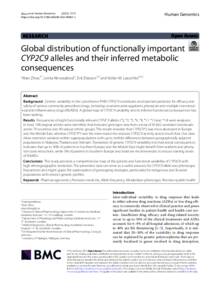Document
Global distribution of functionally important CYP2C9 alleles and their inferred metabolic consequences.
Contributors
Gregorian
2023-02
Language
English
English abstract
Abstract
Background Genetic variability in the cytochrome P450 CYP2C9 constitutes an important predictor for efcacy and
safety of various commonly prescribed drugs, including coumarin anticoagulants, phenytoin and multiple non-steroi dal anti-infammatory drugs (NSAIDs). A global map of CYP2C9 variability and its inferred functional consequences has
been lacking.
Results Frequencies of eight functionally relevant CYP2C9 alleles (*2, *3, *5, *6, *8, *11, *13 and *14) were analyzed.
In total, 108 original articles were identifed that included genotype data from a total of 81,662 unrelated individuals
across 70 countries and 40 unique ethnic groups. The results revealed that CYP2C9*2 was most abundant in Europe
and the Middle East, whereas CYP2C9*3 was the main reason for reduced CYP2C9 activity across South Asia. Our data
show extensive variation within superpopulations with up to tenfold diferences between geographically adjacent
populations in Malaysia, Thailand and Vietnam. Translation of genetic CYP2C9 variability into functional consequences
indicates that up to 40% of patients in Southern Europe and the Middle East might beneft from warfarin and pheny toin dose reductions, while 3% of patients in Southern Europe and Israel are recommended to reduce starting doses
of NSAIDs.
Conclusions This study provides a comprehensive map of the genetic and functional variability of CYP2C9 with
high ethnogeographic resolution. The presented data can serve as a useful resource for CYP2C9 allele and phenotype
frequencies and might guide the optimization of genotyping strategies, particularly for indigenous and founder
populations with distinct genetic profles.
Member of
Category
Journal articles

